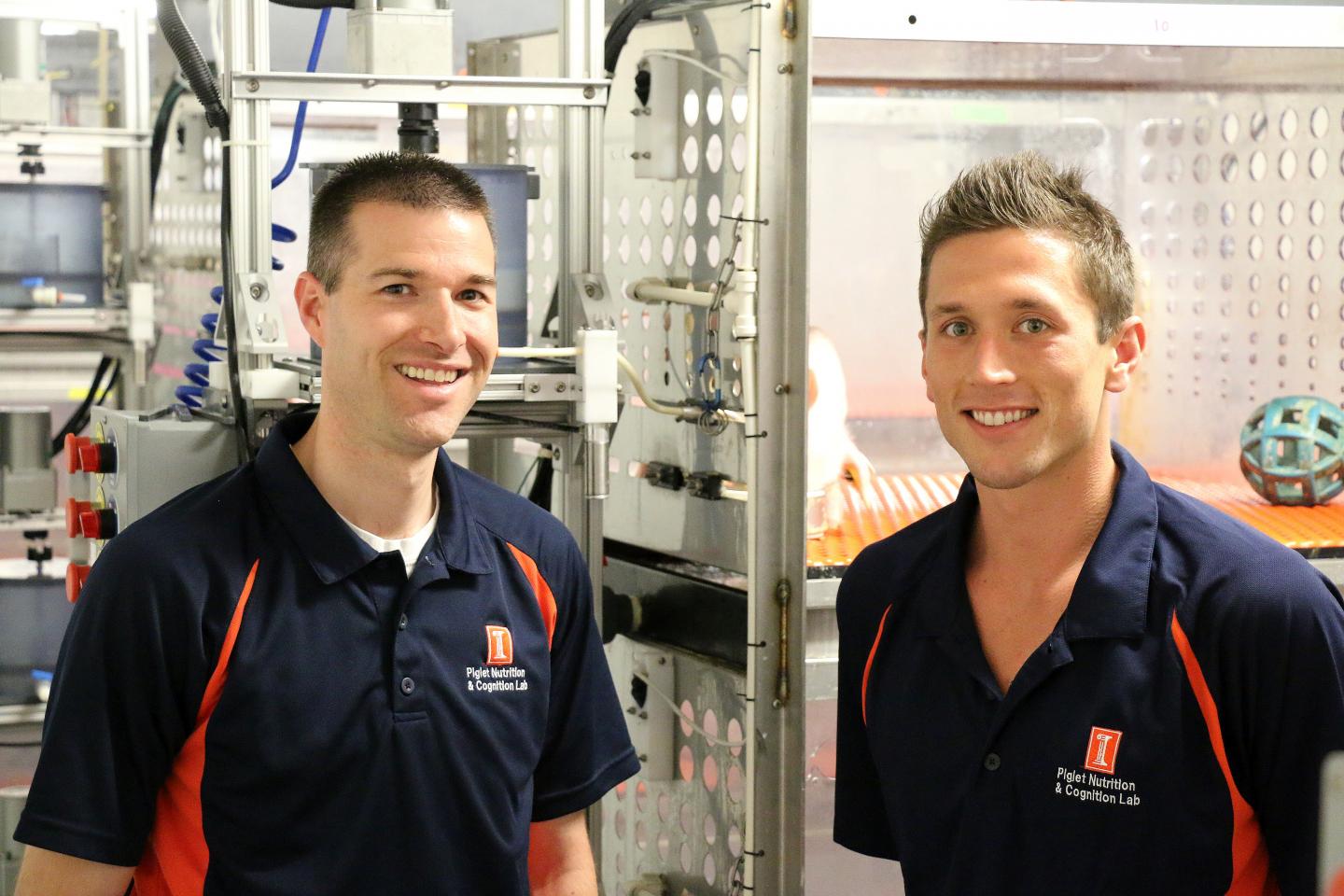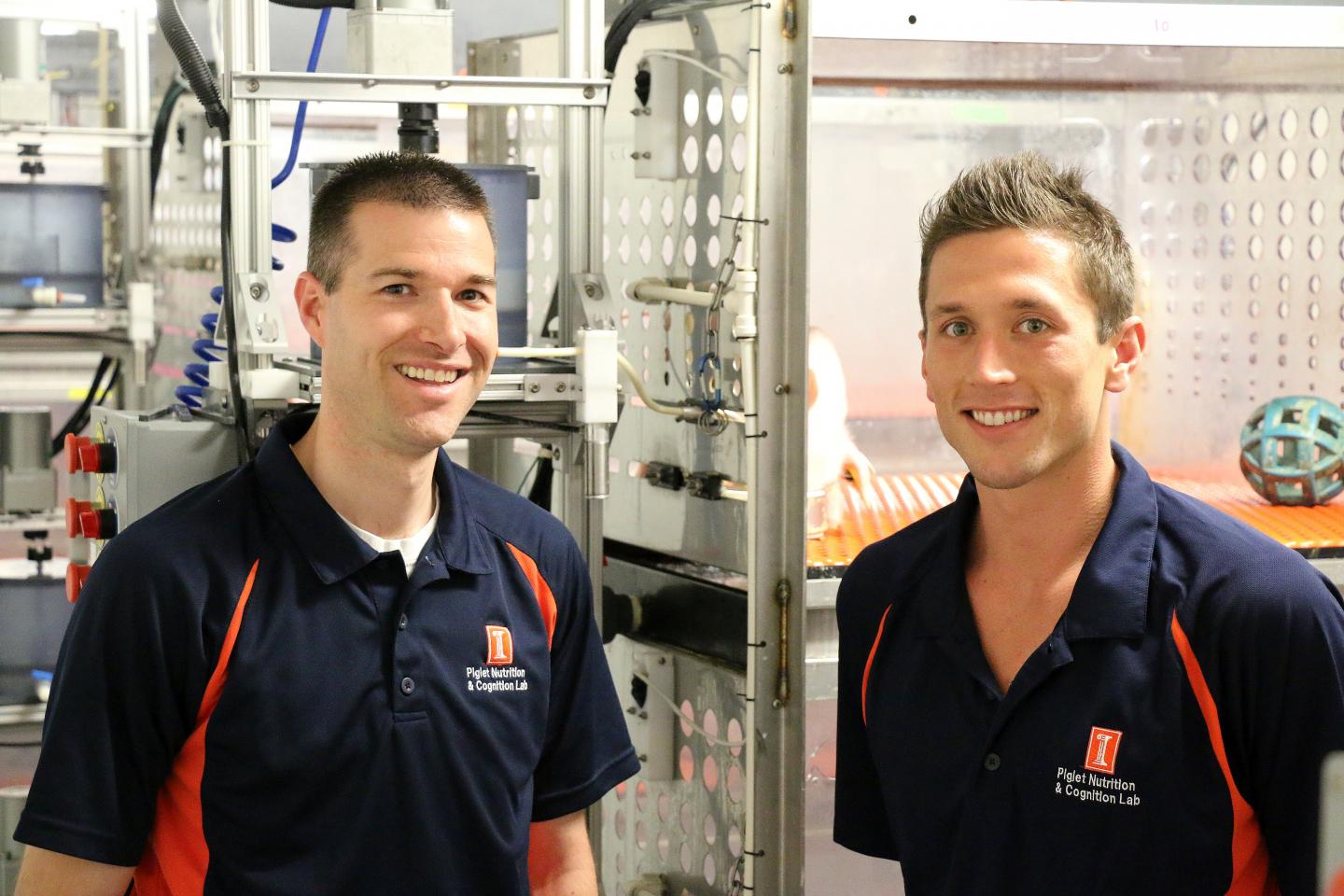
Credit: Photo courtesy of University of Illinois
URBANA, Ill. -Pediatric nutrition research has sh own the important effects of early-life nutrition on a baby's development–especially the gastrointestinal tract–and more recent research indicates that nutrition may also have an influence on an infant's brain as it develops.
Does nutrition in the first weeks of life play a bigger role in later behavioral outcomes like memory and fine motor skills?
For nearly a decade, researchers at the University of Illinois have studied the piglet as a translational model to understand which aspects of early brain development are affected by nutrition interventions.
Because of striking similarities in human infant and piglet brain development patterns, studies using the piglet have helped lead to advances in pediatric nutrition. This is important as makers of infant formula seek to create a product that more closely reflects the composition of a mother's milk.
In a recent review article published in Advances in Nutrition, Ryan Dilger, a U of I animal scientist and Austin Mudd, a doctoral student in the neuroscience program, provide background for the work they do with nutrition and neurodevelopment using the piglet as a model.
The new paper highlights several studies on pediatric nutrition of which brain development outcomes were the primary interest. The paper also describes technologies, including advances in magnetic resonance imaging (MRI), that are being used to assess brain development, as well as outlines areas for future nutrition and neurodevelopment research.
"This review integrates all the background material for what we do in our lab. We are hoping that this serves as a reference that others can go to for why we use the piglet to study pediatric brain development," Dilger says. "It's the cornerstone for what we've been studying."
The hope with the review is to standardize the types of outcomes that are used to assess brain development, Dilger says, and then to find out which of those outcomes are sensitive to dietary interventions.
Part of that is having a clear understanding of how the infant brain is developing in the early days and weeks after birth. Dilger explains, "The brain is made up of individual regions that are interconnected in what they do and how they function, and in the way they are growing and maturing over time."
MRI methods have allowed researchers to characterize volume changes in areas of the piglet brain from 2 to 24 weeks of age, showing a similar growth pattern as of that in human infants. Mudd describes that one month of volumetric brain growth in a human is approximately equivalent to 1 week in piglet growth. This allows for assessment of learning and memory during critical times of brain growth, which can be translated to humans.
"When people first started researching the pig and nutrition and brain outcomes, they were only weighing the brain or assessing global fatty acid content of the brain. However, we know from human work that different brain regions mature at different rates. So you may not see an effect of dietary intervention in the whole-brain, but if you were to look at specific brain regions at different time points you might see a dietary effect. It is clear now that we should be looking at individual brain regions in a dietary intervention study, rather than assessing the brain as one unit. From these types of studies, we can start to identify optimal windows in which developing brain regions are differentially sensitive to nutrition," Mudd says.
Dilger explains that previous nutrition research has focused on the effect of fatty acids in milk (or infant formula), but in the review the researchers discuss studies on other aspects of milk composition such as choline, iron, cholesterol, amino acids, milk fat globule membranes, and other milk bioactives, including sialic acid, gangliosides, and alpha-lipoic acid.
Another important aspect of the review is a listing of techniques that are available and that have been used in assessing neurodevelopment in the piglet. Some of those techniques include advanced MRI methods, such as voxel-based morphometry, which compares gray and white matter tissue volumes, and diffusion tensor imaging, which measures microscopic water movement in the brain and helps infer structural changes.
Other techniques described involve behavioral assessments with piglets, such as spatial mazes, to assess learning and memory. References to what dietary references were used with each method have also been provided.
"A focus of this paper is standardizing the procedures we use," Dilger says.
Dilger says he also hopes the review can help nutritionists understand the neurodevelopment side of pediatric nutrition and research. "It is written for a nutrition audience, but it translates the language that a neuroscientist would use."
"As a review, it is less about reporting novel findings and more about focusing on what is known to date. The novelty is bringing the neuroscience piece into the nutrition realm and helping nutritionists to understand and to better interpret their findings," he adds.
Although Dilger's lab is not alone is studying early-life nutrition and development using the piglet model, he explains that their partnership with the U of I Beckman Institute has allowed a unique opportunity to use advanced MRI equipment and access to technicians. Along with U of I researchers Rod Johnson and Brad Sutton, Dilger also helped to create a pig brain atlas that has been made public for use by other researchers. Dilger adds that upgrades to that atlas to a higher resolution and that shows more brain areas will enable even greater sensitivity in understanding brain development outcomes.
The work in Dilger's lab continues to draw from a long history of using the neonatal piglet as a translational model to study pediatric nutrition at the U of I. Sharon Donovan a food science and human nutrition researcher, along with Johnson, an animal sciences researcher have used the young pig to understand how nutrition influences the immune system and microbial ecology of the neonate, as well.
"Early-life nutrition and neurodevelopment: Use of the piglet as a translational model" is published in Advances in Nutrition. Co-authors include Austin T. Mudd and Ryan N. Dilger. The article can be accessed online at http://advances.nutrition.org/content/8/1/92
###
Media Contact
Stephanie Henry
[email protected]
@ACESIllinois
http://aces.illinois.edu/
############
Story Source: Materials provided by Scienmag





